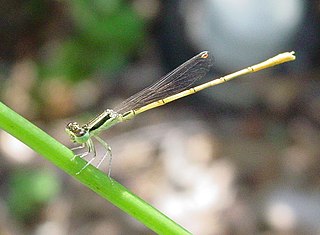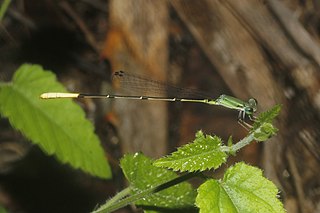
The insect family Coenagrionidae is placed in the order Odonata and the suborder Zygoptera. The Zygoptera are the damselflies, which although less known than the dragonflies, are no less common. More than 1,300 species are in this family, making it the largest damselfly family. The family Coenagrionidae has six subfamilies: Agriocnemidinae, Argiinae, Coenagrioninae, Ischnurinae, Leptobasinae, and Pseudagrioninae.

The citrine forktail is a damselfly of the family Coenagrionidae.

Ischnura aurora, the gossamer damselfy or golden dartlet and also known as the aurora bluetail, is a species of damselfly in the family Coenagrionidae.
"Cochranella" geijskesi, also known as the Wilhelmina Cochran frog, is a species of frog in the family Centrolenidae. It is endemic to Suriname. Its natural habitats are subtropical or tropical moist lowland forests and rivers.

The sharpsnout stingray or wingfin stingray is a species of stingray in the family Dasyatidae, found from off Venezuela to northern Brazil. It inhabits shallow, brackish water, shifting towards the coast in the dry season and away from it in the rainy season. Typically measuring 70 cm (28 in) across, this dark brown ray is easily identifiable by its long, projecting snout and elongated, acutely pointed pelvic fins. Its diet consists of bottom-dwelling invertebrates. Reproduction is aplacental viviparous, with females bearing one to three pups annually. Naturally uncommon and slow-reproducing, the sharpnose stingray is under pressure by both artisanal and commercial fisheries, leading the International Union for Conservation of Nature (IUCN) to assess it as critically endangered.
Azuragrion granti, the Socotra bluet or Grant's bluet, is a species of narrow-winged damselfly in the family Coenagrionidae. It is endemic to Socotra in the Indian Ocean. It is a member of the narrow-winged damselfly family Coenagrionidae with its closest relatives originating in Africa, for example Azuragrion nigridorsum.

Leptobasis is a small genus of damselflies in the family Coenagrionidae. They are commonly known as swampdamsels. The genus is neotropical and one species, L. melinogaster, has been recorded in Texas. They are slender and the females have very long ovipositors.

Enallagma traviatum is a species of small damselfly in the family Coenagrionidae. It is commonly known as the slender bluet. The slender is small about 29–32 mm in length.

Aciagrion hisopa, is a species of damselfly in the family Coenagrionidae. It is abundant in many South Asian countries, but populations in Sri Lanka is still in doubt.
Denticulobasis dunklei is a species of damselfly in the family Coenagrionidae first identified in Loreto, Peru.
Denticulobasis garrisoni is a species of damselfly in the family Coenagrionidae first identified in Rondônia, Brazil.
Denticulobasis ariken is a species of damselfly in the family Coenagrionidae first identified in Rondônia, Brazil.
Tuberculobasis arara is a species of damselfly in the family Coenagrionidae first identified in Rondônia, Brazil.
Tuberculobasis guarani is a species of damselfly in the family Coenagrionidae first identified in São Paulo, Brazil.
Tuberculobasis karitiana is a species of damselfly in the family Coenagrionidae first identified in Rondônia, Brazil.
Tuberculobasis macuxi is a species of damselfly in the family Coenagrionidae first identified in Roraima, Brazil.
Tuberculobasis tirio is a species of damselfly in the family Coenagrionidae first identified in Pará, Brazil.
Tuberculobasis williamsoni is a species of damselfly in the family Coenagrionidae first identified in Colombia and Venezuela.

Argia vivida, the vivid dancer, is a species of narrow-winged damselfly in the family Coenagrionidae. This species is commonly found in springs and forests Central America and North America. Argia vivida inhabit areas of diverse temperatures due to thermoregulation. The species is also considered the state insect of Nevada.







